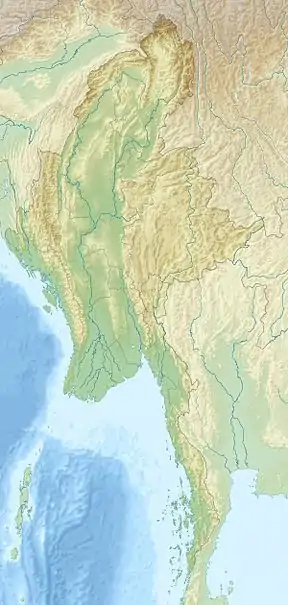| Mahamyaing Wildlife Sanctuary | |
|---|---|
| Burmese: မဟာမြိုင် တောရိုင်းတိရစ္ဆာန်ဘေးမဲ့တော | |
IUCN category IV (habitat/species management area) | |
 Mahamyaing Wildlife Sanctuary Location in Myanmar | |
| Location | Sagaing Region, Kalay and Mawlaik Townships, Myanmar |
| Nearest city | Mawlaik |
| Coordinates | 23°21′00″N 94°40′00″E / 23.35000°N 94.66667°E |
| Area | 1,181 km2 (456 sq mi) |
| Established | 2002 |
| Governing body | Myanmar Forest Department |
Mahamyaing Wildlife Sanctuary is a protected area in Myanmar's Sagaing Region, covering an area of 1,181 km2 (456 sq mi).[1] It ranges in elevation from 145 to 590 m (476 to 1,936 ft) and was established in 2002 in Kalay and Mawlaik Townships.[2]
History
The area of Mahamyaing Wildlife Sanctuary used to be five reserve forest blocks with logging concessions.[1] In 2002, it was proposed as a wildlife sanctuary, and forest rangers were employed. It was designated an Important Bird Area in 2010.[3]
Biodiversity
Flora
Mahamyaing Wildlife Sanctuary encompasses mostly mixed deciduous forest interspersed with some evergreen forest species. The forest is degraded and dry dipterocarp in the sanctuary's buffer zone.[1] The tree species include Teak (Tectona grandis), Pterocarpus macrocarpus, Xylia dolabriformis, and Shorea siamensis.[4]
Fauna
Wildlife recorded during a camera trap survey in the winter of 1999 to 2000 comprised yellow-throated marten (Martes flavigula), large Indian civet (Viverra zibetha), small Indian civet (Viverricula indica), clouded leopard (Neofelis nebulosa), Asiatic golden cat (Catopuma temminckii) and leopard cat (Prionailurus bengalensis).[5][6] Also present are Asian elephant (Elephas maximus), banteng (Bos javanicus), gaur (Bos gaurus), sambar deer (Cervus unicolor), Indian muntjac (Muntiacus muntjak), wild boar (Sus scrofa), eastern hoolock gibbon (Hoolock leuconedys), Rhesus macaque (Macaca mulatta),[1] Asiatic wild dog (Cuon alpinus), Javan mongoose (Herpestes javanicus) and jungle cat (Felis chaus).[2] The critically endangered Chinese pangolin (Manis pentadactyla) and Sunda pangolin(Manis javanica) occur as well as more than 86 bird species and 74 butterfly species.[7]
References
- 1 2 3 4 Brockelman, W. Y.; Hla Naing; Chit Saw; Aung Moe; Zaw Linn; Thu Kyaw Moe; Zaw Win (2009). "Census of Eastern Hoolock Gibbons (Hoolock leuconedys) in Mahamyaing Wildlife Sanctuary, Sagaing Division, Myanmar". In Lappan, S.; Whittaker, D. J. (eds.). The Gibbons: New Perspectives on Small Ape Socioecology and Population Biology. New York: Springer. pp. 435–451. ISBN 9780387886046.
- 1 2 Beffasti, L.; Gallanti, V., eds. (2011). "Maharmyaing". Myanmar Protected Areas: Context, Current Status and Challenges (PDF). Milano, Yangon: Istituto Oikos, Biodiversity and Nature Conservation Association. p. 58.
- ↑ Thazin Wai, K.; Trisurat, Y.; Sukmasuang, R. (2017). "Comparison of Small Mammal Communities in Logged and Unlogged Areas in the Proposed Mahamyaing Wildlife Sanctuary, Myanmar" (PDF). Journal of Tropical Forest Research. 1 (2): 1–20.
- ↑ Kyi Kyi Sway (7 April 2017). "Forest reserves to be recognised as wildlife sanctuaries". Myanmar Times. Retrieved 2 December 2019.
- ↑ Than Zaw; Saw Htun; Saw Htoo Tha Po; Myint Maung; Lynam, A. J.; Kyaw Thinn Latt; Duckworth, J. W. (2008). "Status and distribution of small carnivores in Myanmar". Small Carnivore Conservation. 38: 2–28.
- ↑ Than Zaw; Than Myint; Saw Htun; Saw Htoo Tha Po; Kyaw Thinn Latt; Myint Maung; Lynam A. J. (2014). "Status and distribution of smaller felids in Myanmar" (PDF). Cat News (Special Issue 8): 24–30.
- ↑ "New Wildlife Sanctuary in Myanmar". Rainforest Trust. Retrieved 2 December 2019.
External links
- BirdLife International (2019). "Important Bird Areas factsheet: Mahamyaing".